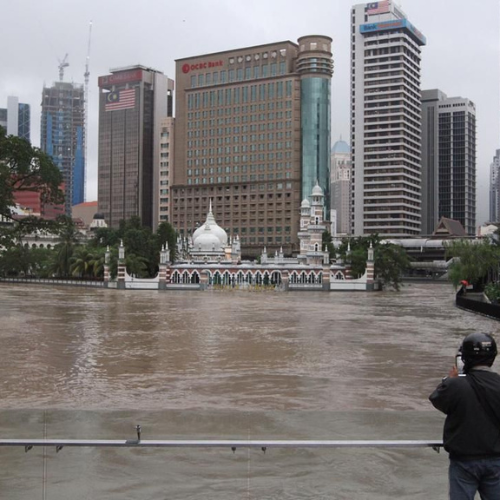Climate change is a reality.
It is not a coincidence that weather events are intensifying and becoming increasingly destructive. Flash floods that follow heavy rainfalls threaten lives and cause property damage. Sporadic droughts are affecting agricultural yields, threatening local food systems. After heatstroke killed a 22-year-old man in the state of Pahang in Malaysia, prolonged heatwaves put schools on high alert of closure.
The relentless rise of extreme weather events compels a bold reappraisal of Malaysia's disaster risk management strategies. A glaring vulnerability lies in the area of preparedness and mitigation. Much of Malaysia’s disaster risk management focuses on emergency response implying an impulsive plaster-patching approach. This inadequacy in solution-seeking stems from our siloed and outmoded approach in thinking about the problem. Climate change is not a series of isolated events; it's a complex web of interconnected systems. Our myopic view, treating climate disasters as anomalies, hinders us from seeking solutions beyond immediate response.
As such, we need a systems thinking approach that recognises these intricate connections. This shift would allow us to identify long-term, preventative measures that build community resilience and fortify infrastructure.
Before delving into the systems approach, however, it's crucial to understand the root causes of the current fragmented way of working. Three key factors contribute to the prevalence of this piecemeal approach:
Compartmentalised Mandate
Under the hierarchical and archaic government structure, climate risks mitigation is still viewed as a matter of top-down regulation. In Malaysia, the mandate of addressing climate change sits only with the Ministry of Natural Resources and Environmental Sustainability, despite its far-reaching effects towards other areas such as the education system, public health, social services, and food security.
The upcoming National Adaptation Plan which intends to address the intersecting areas such as public health, agriculture, water resources, and urban planning is seen as a welcome step. However, ensuring effective implementation necessitates addressing potential challenges associated with departmental silos within the public sector. Current performance evaluation system in the government, which may overemphasise individual departmental objectives, could hinder a truly collaborative approach.
This compartmentalisation also extends to private sector too. While more than half of the companies in Malaysia has a dedicated department steering sustainability strategy, less than 25% of the top companies meaningfully integrate climate action into business leadership.
Isolated Strategies
Existing strategies in addressing climate risks remained passive and siloed. For example, the act of providing post-disaster cash transfer, in mere tokenistic amount no less, does not bring much impact if there is no guarantee against future climate-related financial loss. The usage of technology such as mobile-based early warning systems, while effective to alert against potential disaster events thus minimising the loss of lives, does little in comparison to the constant threat from the larger environment.
While over-urbanisation is recognised as one of the causes for flooding, there is a clear dissociation between the government’s mitigation and development policies. The numerous infrastructure projects that partly alleviated flooding for the residents in Segamat for example, were pursued in tandem with a property development project situated at a previously forested area by the riverbank – a case of the left hand being unaware of the right.
Abstracted View
Political and business elites occupying decision-making roles remain tone deaf to the realities on the ground, further widening the disconnect between their understanding of the issue and the lived experience on the ground.
Farmers can quantify the amount of food loss and predict spiking vegetable prices due to a prolonged monsoon that crop health. School teachers in Kedah can expect more students falling sick and skipping class due to a prolonged heatwave. Parents will observe a 20% increase in prevalence of malaria case among their children as the global temperature head towards the 2-degree mark.
The consequent effect of the disconnect is that individuals with power and resources to bring about change, which often are the biggest emitters themselves, fail to fulfill their obligations to advance climate action. This translates to failure in enacting effective policy reforms.
Adopting Systems Thinking
There is a need for policymakers and leaders to act in a concerted manner, crossing the chasm of silos to inspire a whole-of-society action. This starts with adopting a systems thinking approach in analysing and addressing climate risks.
Systems thinking is a holistic approach sets the vantage point at the “big picture”, examining how individual components interact within the whole system. It is about looking beyond single elements to understand how the interplay of multiple feedback loops influences the system as a whole. It recognises the cause of an issue can be multifaceted and confounding, and likewise its solution.
Taking a conscious step back to see the whole picture allows us to observe the fine interactions between climate, economy, social protection, and public health systems. Our solution-making process will be more robust the further we look, incorporating diverse perspective and knowledge from multiple actors in the systems.
The Bigger Picture
A systems approach to public policy will allow leaders to consider the institutional and non-institutional barriers and enablers in the policymaking process. Instead of reinventing the wheel and launching yet another hollow five-years plan, administrators will seek possible solutions within the existing mechanisms and norms. For example, Indonesia’s designation of 12.7 million hectares of land for social forestry, a national programme that grants direct ownership to community members for sustainable resource management, is built upon existing practices of community forest adoption. The initiative, managed by the Ministry of Environment and Forestry who plays a turnkey role, helps Indonesia to achieve its biodiversity conservation target while ensuring sustainable livelihood for its people.
Besides introducing punitive action in regulation, government will also put in place incentive systems to accelerate the policy adoption process meanwhile ensuring the whole interaction is intuitive, accounting not only “carrot” and “stick” but also the “string” that holds them both. China’s various financial incentives to encourage solar panel installation are coupled with other measures to keep the production cost low such as subsidised land rate for solar panel factories and low-interest bank loan from state-owned banks, which greatly enhanced the country’s renewable energy transition.
Business leaders who adopted the systems approach will be equipped with the ability to assess their business standing not only in financial terms, but their readiness to face major global trends such as climate change. Leaders with deep appreciation of their role in influencing the greater economic system will be confident to take the leap of faith, working complementarily with public policy instead of antagonistically.
Individuals will anchor their action with the firm understanding on how self-leadership can create a ripple of change in the wider system. Marginalised communities will be empowered to take matters into their own hands, sourcing solutions from a collective of local and traditional knowledge, flipping their role from passive reactors to active contributor of climate solutions. The coastal communities of Malampaya Sound in Palawan Province, Philippines, are active participants in a mangrove reforestation project. Their indigenous Tagbanua beliefs confers an additional layer of protection to mangrove ecosystem by deterring destruction of the forest.
The escalating climate crisis demands nothing less than a radical transformation. Malaysia must abandon piecemeal solutions and embrace a systems thinking approach. This requires shattering the walls between government agencies, fostering collaboration across all sectors, and harnessing the collective will of the nation. Only then can a resilient future be nurtured – one where Malaysia weathers not just the storms of a changing climate, but emerges stronger, more united, and prepared to thrive in the face of adversity.


























